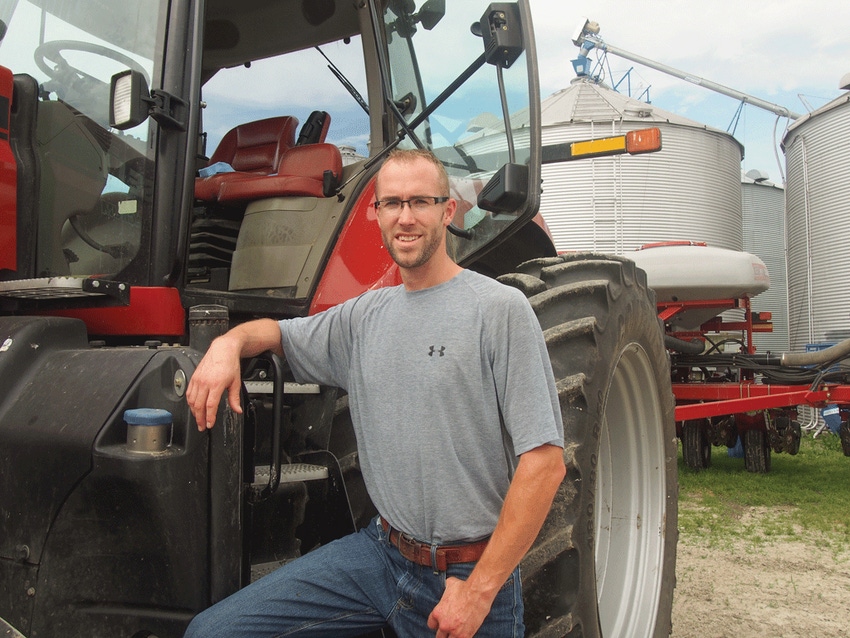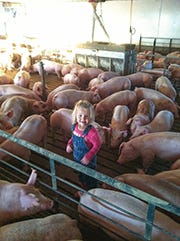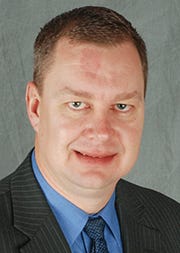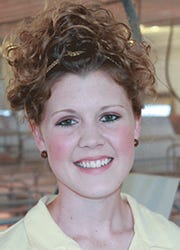Opening hog barns to the masses
Hog producers are using social media and other technology to open their barn doors to the scrutinizing public.

More stringent biosecurity measures have greatly reduced the number of tours allowed on American hog farms. This tightening of security comes at the same time that the consuming public scrutinizes what goes on with the animals inside the barns.
Though farmers close their barn doors to outside traffic for disease control purposes, antagonistic agricultural opponents will say hog farmers are trying to hide something. With that in mind, hog producers have been using technology to open their barns’ doors to the outside world.
Thomas Titus of Elkhart, Ill., has been using a variety of social media platforms for a few years now to share stories from and about his central Illinois farm, as well as the story of the pork industry. Titus started sharing his life in 2005 using Facebook while he was in college, “and it has evolved from there.” He completed the Pork Leadership Institute through the National Pork Producers Council, a program to develop future leaders of the pork industry, but he really saw his involvement take off when the National Pork Board unveiled its #RealPigFarming social media outreach program a couple of years ago.
Titus attempts to post something every day, maybe a couple of times a day, to Twitter, Facebook, Snapchat or Instagram. His posts may be a photo, a comment or both. It may be agriculture-related. It may be family-related. It may be both. “You can’t just be a talking puppet for the industry. You don’t want to just talk about the good things you’re doing on the farm, because we’re all doing good things on the farm, but you want to show the consumer that we’re real people,” Titus says.
Titus’ Twitter descriptor sums up his mission pretty well: “Working to tell our farm’s diverse story. We are an open book, feel free to reach out and ask.”
“I try to give a balanced approach, showing us in the barns with the pigs, but also just being a family,” he says.
Having discovered that “cute sells,” Titus posts a lot of activity with his two young daughters participating in life on the TriPork Inc. farm, where he works with his in-laws.
“I show my daughters a lot,” he says. “I want to show that family is important on our farm, and having them beside me is a great way of life, and I wouldn’t have it any other way. … they are the next generation, and they’re the ones who will be caring for the livestock and the land for the next 50 years. They’re extremely involved because we want to continue that legacy.”
By picturing family both in farm situations and just being a family, Titus shows his social media audience that farmers are human. And, he is gaining a following. A couple of years ago he had fewer than 30 followers on Twitter, and that total has mushroomed to almost 1,600. On Facebook, he is followed by more than 3,400 and more than 800 on Instagram. Keep in mind that there may be some crossover users between the platforms.
Though social media platforms call the connections followers, Titus sees them more as engagements, involving the follower in dialogue. He says farmers don’t think about what they are doing as really exciting. They think it’s mundane. “But to people who do not have an agriculture background, our mundane can be exciting and interesting to them.”
Titus says the #RealPigFarming “community” (other pork producers using social media) is pretty tight-knit, and they continually discuss what’s being talked about on the internet.
Already admitting that “cute sells,” Titus says the posting of photos of his young daughters or young nephews hooks an audience to follow him online. With that relationship made, Titus says it is more conducive to open further dialogue once an actual farming practice comes into question. “Then when I do get into the meat-and-potatoes of discussing antibiotic use on our farm, or utilizing gestations stalls or freestalls or specific production practices, you’ve got that audience in place, and you’ll rank higher in their ‘news feed’ when they log into Facebook,” he says. “You’re building a rapport with people who are following you. That’s what’s nice about social media — you can engage in dialogue with someone in an entirely different country to tell them about our practices and why we do what we do on the farm.”
One such connection happens to be with a hog producer near Mexico City, and the conversations between them have been eye-opening to say the least, signifying how serious issues are relative. “We talk about once every other month. It’s interesting what our concerns are. In the U.S. we are concerned about exports, input costs, the price of corn and soybean meal, and our bottom line. In Mexico City, his concern is his personal safety. He has to take an armed guard with him every time he goes to his barn after dark, because farmers are looked at as someone with great personal wealth.” All of a sudden, farrowing crates do not seem to be such a big issue.
Titus relishes that social media allows such conversations to take place, to learn what others are experiencing. He also sees the benefit of social media as opening a dialogue between him and consumers from around the globe, “simply answering some questions of why we do things the way we do in the U.S.”
While Titus sees the importance, and is quite active in these social media conversations, being able to reach a great number of people with little effort, sometimes it is still necessary to have your audience with boots in the barn.
“Utilizing social media is a good tool, but it’s much more impactful if you can get that person on your farm, one-on-one, and build that relationship,” he says, “and have them understand what you put in every day. Pictures and dialogue on social media are great, but when you can get them holding a baby pig, and seeing what goes into making that pig ration to help them grow, and how much care and time goes into their care, that’s very impactful for the consumer. … to have them see that we are caring for our animals, and we’re working with our veterinarians to provide the best and most comfortable environment that we can, and what we’re doing to keep the animals healthy.”
At the end of the day, regardless if it’s a face-to-face interaction or a social media discussion, Titus has a personal goal of impacting one person. “If I can make an impact on one person, change their perception,” he says, “then I’ve done my job.”
Good use of time
In many ways, technology has become a farmer’s best friend, from running their equipment to running their barns to allowing barn visits without letting a sole inside.
Jeff Wuebker of Versailles, Ohio, has been opening his farrow-to-wean farm to visitors for years, including visits by John Boehner, former speaker of the U.S. House of Representatives, and a group of food bloggers.
“Those visits took a lot of time to get ready for, making sure everything was cleaned up and there wasn’t anything out of place,” he says. Wuebker still opens his barns to outsiders, but now he is the only one who actually sets feet on the slats.
Last year the Ohio Pork Council started its “Virtual Field Trip to an Ohio Pig Farm” program in partnership with Farm Credit MidAmerica. It brings Wuebker’s farm to classrooms around the Buckeye State.
Armed with an iPad and Bluetooth sound-reduction microphone, Wuebker gets ready for the classroom “visit” 30 to 45 minutes before the presentation is to begin. Once technology checks have been made, the students are settled in front of their cameras, and OPC moderator Jennifer Osterholt is in place, it’s showtime.
“Even in rural areas these kids don’t always get positive messages about agriculture,” Wuebker says. “We need to expose them to as many positives as possible.”
Most of the classrooms “visiting” Wuebker’s farm are elementary level, though some FFA and agriculture education programs also participate. “We cater the subject matter depending on the group we are presenting to,” he says. Wuebker’s farm is a 2,000-sow farrow-to-wean operation, and the younger students like the piglets, so he spends more time with them. With the FFA and ag-ed high school students, other topics such as career potential are discussed. Five full-time employees help Wuebker on the farm, and he occasionally tries to get them in front of the camera.
Each presentation is 30 to 45 minutes, and Wuebker says time flies. “You really need to stay on task,” he says. “Jennifer [Osterholt] will lead me to move on.”
If time allows, each presentation ends with a question-and-answer session, and Wuebker likes getting the students involved. “I can see them, and they can see me, so I try to pick out a student and say ‘that boy in the red shirt, do you have a question?’ I think that is a good way to show that we have that connection with them.”
Wuebker plans to keep participating as long as he can, as he sees incredible potential in such programs, even taking it beyond classrooms to educate all walks of life. “The potential is unlimited,” he says.
Open doors to experiences
“I truly believe that if we show inside our barns, and we show how much we care, I think people will think differently the next time that they go purchase pork,” says Lauren Schwab, hog farmer from Somerville, Ohio, who also participates in the OPC’s virtual barn tours. “Many people who have negative thoughts about hog farming have never talked to a farmer before, so if they can have that one-on-one with a farmer and see inside our barns and see how content those piglets are lying under the heat lamp, they’ll have a different idea about farming.”
Schwab had taken the pork message to classrooms through “Pork in the Classroom” presentations, “but even though they were learning about pigs, they didn’t get to experience pig barns, so this [virtual tours] was a way that we could open the doors to people,” she says.
Schwab and Wuebker are just two of the Ohio pork producers teaming up to bring the pork stories to classrooms.
Schwab manages her family farm’s farrowing unit in the farrow-to-wean operation, so her virtual tours are mainly in the farrowing unit. It also helps that that barn offers the best internet connection, a necessity to these technological tours.
“I’m mostly in the farrowing barn all day anyway, so I explain how I feed the sows, and I show them a feed sample, and when I say ‘sow,’ I tell the children that’s a mother pig,” she says, explaining that she also has to further explain common hog farming terms so that elementary students will understand. For example, she says she is in the farrowing room, or birthing room. When talking about “weaning,” she explains that “the mothers come in here to give birth, and when the pigs are 2½ to 3 weeks old, they are then big enough to quit nursing off their mother, and they’re big enough to start eating real feed.” She further explains that the weaned pigs will then be moved to be raised by another farmer who will market the hogs.
As Thomas Titus says, “cute sells” and the students like seeing the piglets, so she does a brief introduction. “I say ‘hi’ and then I turn the iPad around and show the pigs, because that’s what they want to see.”
Most of the classes Schwab has welcomed into her barns are from urban and rural districts in Ohio, but she recently offered a Wisconsin classroom barn access since that state’s pork organization is starting a similar program. She can gauge her audience demographics by the questions asked, as students from a rural district may ask about specific breeds, while the urban students ask, “What do the pigs do? Do they play? Do they fight?”
A couple of common questions, so common that they get asked multiple times during a single tour, are “How big do pigs grow?” and “How fast do they grow?”
Regardless where the questioning goes, Schwab has her go-to message. “I make it a priority to say how we have regular checkups from our veterinarian and how we all have to be certified through Pork Quality Assurance,” she says. “I had the opportunity to travel to Japan with National FFA and to see U.S. pork in those grocery stores. I see it’s so important to me to give these animals the best care possible. That’s a message I always try to get across if they ask it or not.�”
In addition to offering virtual barn tours, Schwab connects with consumers through other social media outlets, including her website and blog, farmgirlwithcurls.com. She attended Miami University, near where she grew up, and majored in journalism, which she puts to use communicating the hog production story.
“After each [virtual tour] presentation I feel satisfaction that people were able to see inside the barn, see what we do, and hear from a farmer firsthand,” she says. “I feel good that they know firsthand how much I care for my animals.”
About the Author(s)
You May Also Like



